Growing up in a state like Kentucky, it’s interesting because in Louisville, the Asian-American population is small, but the Filipino population is even smaller. I didn’t realize what it’s like to be part of the minority until around 2nd or 3rd grade. I noticed that I was different because I had tan skin, while the majority of my classmates were Caucasian. Once I learned more about my cultural background, appreciating it was difficult... and sometimes I was actually embarrassed of it.
Elementary school was difficult for me. I felt like an outcast, and it seemed like nobody wanted to be my friend. From having several “lunchbox” moments to wearing a dress made in the Philippines for my first communion, I was uncomfortable because I didn’t like being different. I’m the kind of person that doesn’t like receiving a lot of attention, so showing off my culture in any way made me a little insecure. When I transferred to a public school in 7th grade, it felt a bit weird, because compared to being in private school, I finally wasn’t the only Asian-American kid in my class. When I first met another Filipino-American student, I hadn’t realized there were more Filipinos in Louisville; the only Filipinos I knew were either family, family friends, or people I knew through my parents.
Throughout my childhood and teenage years, I’ve noticed how small the Filipino community is in Louisville. The only times the community gathered together was usually during events like Simbang Gabi and an annual Miss Filipino-American (Fil-Am) Pageant that was hosted by a Filipino-American organization for the Greater Louisville and Southern Indiana region. I never enjoyed going these type of events though, because the people who usually go are older folks and parents with younger children. These weren't like your typical pageants; contestants had to raise money for the Fil-Am community, and whoever raised the most money was crowned Miss Fil-Am. When I was younger, I never understood why we had these type of events, but as I got older, I realized that they really allowed the Filipino community to come together. During my junior year of high school, I was crowned Miss Fil-Am, and there were three other girls that were crowned as Miss Visayas, Miss Mindanao, and Miss Luzon. As a U.S. born Filipino-American, I was afraid of losing connection with my Filipino roots, as I had grown up surrounded by the strong influence of American culture. But being in this pageant made me realize that having events like these is a way to get younger Filipino-Americans involved in the Filipino community, and participating in other community events helped me gain a better understanding of my culture.
By the time I got to high school, I started developing a greater appreciation for diversity. I enjoyed going to school with people of different ethnic and cultural backgrounds–not only did I get to learn about their different cultures, but also it gave me the opportunity to teach my peers about the Filipino culture. Even though the majority of my friends were Caucasian, I was comfortable knowing I wasn’t the only person of color in my friend group. There are my friends from school, where I can be myself and not worry about being living up to any "Filipino standards", and there are also my Filipino friends who I can relate to with pretty much anything, and we can proudly embrace being a Filipino-American together. But between these different friend groups, however, I felt like I needed to be a different person, depending on which group I’m with. Being with these groups separately was fine, but whenever these groups come together, during times like my birthday or when I decide to bring my Caucasian friends to Filipino events, I felt like I had to be two different people. There have been times when both groups have interacted pretty well, but other times, I felt like I have to switch character between groups; not only was this exhausting, but also I hated to have one group feel left out.
Then there's my family and the other elders in the Filipino community. Whenever I'm around them, I feel like I have to live up to their standards or expectations. Most of them are friends with my Lolo and Lola, and with my titos and titas on my dad's side of the family, I’ve been expected to be next family doctor, just like my dad. It’s a pretty big expectation, but even though I want my family to be proud of me, I still want to be able to make myself happy. Whenever I’m with my non-Filipino friends, it's nice not having to live up to any of those expectations, but it does feel a little weird to be the only non-white person in my friend group. Although I’ve gotten used to it, there have been times where I felt outcasted from them, such as when they talk about tanning or getting sunburned.
It wasn’t until I started college where I realized how much diversity and Filipino culture meant so much to me. Being a co-founder and part of the first executive board of the Filipino American Student Organization at the University of Kentucky is an achievement that I’m so thankful for. Without it, I wouldn’t have had opportunities to be a MAFA representative, an ambassador for Empowering Pilipino Youth through Collaboration (EPYC) program, or the chance to meet so many other Filipino Americans in other schools across the country. I love being able to spread my Filipino culture to my fellow peers on campus, while also celebrating and appreciating the history and heritage of my family.




Comments